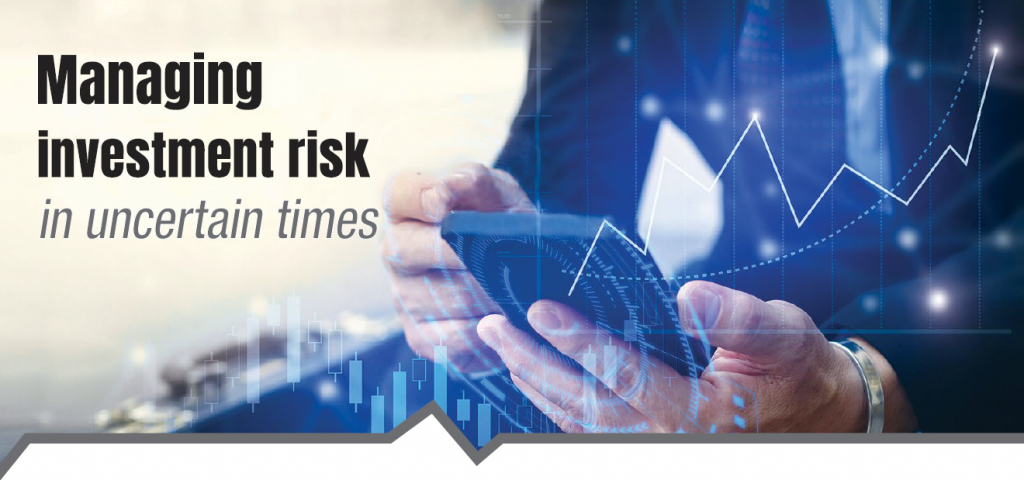
This year has exposed investors to the end of a bull market and the start of a global recession, all caused by a totally unexpected global pandemic. The outlook for the global economy and investment markets remains uncertain until an effective vaccine is available.
While there is cause for optimism that one of the many vaccines will become available in the not-too-distant future, the road to financial recovery – for nations and many individuals – could be much longer.
Whether you are working towards major financial goals such as buying a home, planning to retire soon, or already retired and looking for reliable income, it’s never been more important to come to terms with uncertainty and manage investment risk.
So how can investors not only survive, but thrive, during this difficult period? Staying the course isn’t easy when you can’t see what lies ahead, but you need to strap yourself in if you want to achieve long-term financial success.
Stay the course
When markets fall sharply, as the sharemarket did earlier this year, it’s tempting to switch to cash investments. All too often, this can mean you lock in your losses at or near the bottom of the market and potentially miss out on the recovery that follows.
After hitting a record high in February, the ASX 200 fell almost 37 per cent by mid-March as the economic impacts of COVID-19 began to sink in. Then against expectations, the market rebounded 35 per cent over the next three months. (1)
Throughout that period, volatility was high with dips of a few percent one day followed by an equally sharp rise the next. But history has shown that it generally pays to ignore the noise.
There have been many studies about the impact of missing out on the best days for a market over a given period. Missing even a few of these days can have a big impact on your long-term returns.
Looking at the Australian market, a hypothetical $10,000 invested in the ASX 200 Accumulation Index (share prices plus dividends) on 30 October 2003 would have turned into $37,735 by 6 September 2020. Missing the 10 best days would have reduced returns by $15,375, while missing the 20 best days would have reduced returns by $22,930. (2)
Manage investment risks
While it’s important to stay invested, that doesn’t mean you should forever sit on your hands and do nothing.
Booming markets can make investors complacent, so a market correction is often a good opportunity to stress test your investments to see if they are appropriate for risk tolerance and personal circumstances.
For example, if you’re in your super fund’s growth option but this year’s roller-coaster markets have kept you awake at night, then perhaps a more conservation option would be more appropriate.
Or if your portfolio has become unbalanced after all the market upheaval, with too much reliance on one asset class or market sector, then you might think about rebalancing your portfolio to plug any gaps.
Investors who are nearing retirement or recently retired may have a greater focus on preserving capital, to provide more certainty that their money won’t run out.
The importance of diversification
Yet even retirees need to balance their need for capital preservation with capital growth, which is another way of saying they still need to diversify their investments.
By diversifying across and within asset classes, you have the best chance of riding out a big fall in any one asset class.
With interest rates close to zero and likely to stay low for some time, investments such as bonds and cash that traditionally provide capital protection with regular income will be hard-pressed to keep pace with inflation.
By including some growth assets such as shares and property in your portfolio, your savings will continue to grow over the long term even as you draw down income to cover your living expenses. Shares and property also provide income in the form of dividends and rent, which retirees can use to diversify their sources of income.
Whatever your age and stage of life, avoiding knee jerk reactions, managing risk and diversification can help you navigate these uncertain times.
If you would like to discuss your investment strategy, please get in touch.
- https://www.asx.com.au/prices/charting/index.html?code=XJO&compareCode=&chartType=line&priceMovin gAverage1 =0&priceMovingAverage2=0&volumelndicato r=Bar&volumeMovingAverage=0&timeframe=
- https://www.dnb.co.uk/perspectives/supply-chain/ global-supply-risk-report-q12018-cranfield.html
